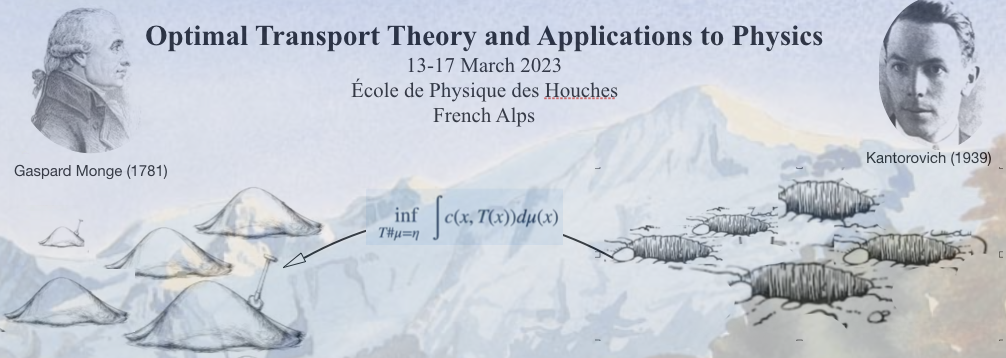
|
|
|
|
Physics Problem-Solving with Optimal Transport Theory
Optimal Transport theory contains the core of the solutions to diverse problems in applied mathematics and physics. Recent advances and developments of fast new algorithms have paved the way for major breakthroughs in different domains of physics. Optimal Transport is also widely investigated in signal processing and machine learning because it defines a distance between very general measures and entities of various nature, essential for object recognition and classification. The basic problem is to transport a probability measure onto another probability measure, while minimizing a given cost of the transport. Although major advances appeared in mathematics, optimal transport bears deep-rooted connections with mechanics and physics through variational calculus.
Following the seminal contributions of Yann Brenier, Mike Cullen, Robert NcCann, Wilfrid Gangbo, Luigi Ambrosio, Cedric Villani and Alessio Figalli and many others, the theory of optimal transportation has recently emerged into a powerful tool for exploring applications both within and outside mathematics. Its impact spans across disciplines: geometry, analysis, dynamics, partial differential equations, economics, machine learning, weather prediction, biology and neuroscience, computer vision, Fluid Mechanics and astrophysics. The goal of this workshop is to describe these recent breakthroughs, highlight connections with physical phenomena and harbour discussions to define new challenges, help start projects between participants and draw new research path in the field. The aim is to exploit applications of optimal transport theory to physical phenomena to bring together different expertise, from mathematics, Physics and computational science. Our aim is to cover the physics/mathematics/ computational aspects of Optimal Transport at the frontiers between the three disciplines. The Program’s top priority is to provide the right environment for creative and somewhat spontaneous, and not rigidly-organised, interactions and discussions between the participants. A few examples of the OT-related physics problems that shall be covered in the conference are:
Applications to Astrophysics (Cosmology and Galactic Dynamics)
The static version of OT has recently been applied to astrophysical data, where the initial density fluctuation field, dating back to the early Universe, has been successfully extracted from the observational data at the present epoch. The application to astrophysics was carried out in a multidisciplinary collaboration includinga few of the organisers (Brenier, Matarrese, Mohayaee) starting in 2002 and recently gained substantial rapidity through a new semi-discrete code that was developed by Bruno Lévy and Quentin Mérigot. Various aspects of applications including relation to Euler-Lagrange action minimisation schemes shall be discussed during the conference.
Optimal Transport and Quantum Physics/Statistical Physics/ Schrödinger problem Optimal Transport theory has received a lot of attention from probabilists. In particular, the Schrödinger problem has been shown to be connected to a stochastic variant of the Benamou-Brenier dynamical formulation of optimal transport. Other related areas are stochastic thermodynamics and the quantum version of Monge-Kantorovich problem. The works of groups are actively working on the generalization of OT to density operators and matrices shall be covered.
Optimal Transport and Fluid Mechanics The interplay between optimal transport and fluid mechanics has been remarkably fertile. Even though the classical Monge Optimal Transport model is static, the modern theory of OT as inspired by Brenier in late nineties, aimed at constructing weak solutions to Euler geodesics variational interpretation, pioneered by Arnold in 1966. This naturally led to the computational fluid dynamics OT model of Benamou-Brenier which can be considered as the first convergent and tractable OT algorithm set out clearly in 2000. In the Benamou-Brenier formulation, time is purely a mathematical convex relaxation tool, but there are several important static and dynamic generalizations of OT related to fluid models and in particular as listed below:
Application of Optimal Transport to Weather and Climate:Semi-geostrophic equation The atmospheric motions that govern extratropical weather and the global general circulation that maintains the climate are both strongly determined by the effects of the Earth’s rotation. The governing equations of motion and thermodynamics can in principle be well-approximated by the semi-geostrophic equations first derived by Eliassen in the 1930s. Crucial contributions have been made by Cullen and Brenier who showed how weak solutions of the semi-geostrophic equations can be characterised as solutions to Monge- Kantorovich problem. Semi-Discrete and Entropic algorithms also raises hopes of computing numerical solutions with more realistic sizes of discretisation. Optimal transport and General Relativity Optimal transport formulation of general relativity in the presence of matter and also cosmological constant had been obtained in terms of convexity/concavity properties of the Shannon-Bolzmann entropy (e.g. works of Andrea Mondino). In a recent work, Yann Brenier has shown that the Einstein equation in the void can be obtained through the Benamou-Brenier dynamical optimal transport formalism. These connections between general relativity and optimal transport shows once again that there is a strong link between general relativity and thermodynamics/information theory. (webpage: https://opti-phy.sciencesconf.org) Scientific organising Committee: Jean-David Benamou Yann Brenier Bruno Lévy Sabino Matarrese Quentin Mérigot Roya Mohayaee |

